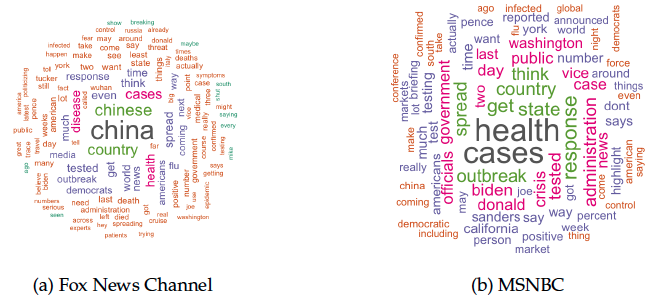The US has more than 210,000 Covid-related deaths to date, a death toll much higher than that of many other developed nations (Aron and Muellbauer 2020). There could be multiple reasons for this, including widespread scepticism towards science (Brzezinsky et al. 2020), large income disparities (Oronce et al. 2020), racial segregation (Bertocchi 2020), and mixed messages from the country’s leadership regarding safety measures (Rafkin et al. 2020). One of the potentially important differences between the US and other countries is media diet. The most watched cable channel in the US is the conservative Fox News Channel, whose hosts were accused of spreading disinformation and minimising the threat of the virus during the initial days of the pandemic.
In January and February of 2020, the most popular commentators of Fox News Channel delivered three types of messages regarding the virus. The first type concerned the potential culpability of China and a conspiracy theory that the virus came from the Wuhan Institute of Virology. The second type suggested that the threat of the virus was exaggerated, and that individuals can self-diagnose Covid-19. The third type of message was that the virus had been used by the Democrats to undermine President Trump. Later, when protests against the lockdowns erupted in Michigan and other states, Fox News covered those favourably while criticising the governors who implemented lockdowns.
To illustrate some of the distinct features of Fox News’ coronavirus coverage, Panel A of Figure 1 plots a word-cloud for paragraphs that include the word "coronavirus" using LexisNexis transcripts of three top-rated Fox News shows ("Hannity", "Tucker Carlson Tonight", and "Ingraham Angle") as well as a similar word cloud of MSNBC transcripts from 1 February to 12 March. For both networks, we excluded the three most common terms: "President", "Trump", and "people." We see that the most common words in MSNBC coverage (Panel B) were "health" and "cases", while for the top FNC commentators, the two most common words were "China" and "Chinese."
Figure 1 Word clouds of COVID-19 coverage for Fox News and MSNBC
Could these messages influence people’s behaviour, making them less likely to comply with social-distancing advice? Our new paper attempts to answer this question (Ananyev et al. 2020). People who watch Fox News might be more conservative to begin with, and thus be reluctant to change their way of life, meaning that a statistical correlation between social-distancing and watching Fox News is not enough to demonstrate causality. To get around this problem, we use a method proposed by Martin and Yurokoglu (2017), who used a fact well-known in the media industry, that people are more likely to watch channels that are ‘lower on the dial’: a channel that is number one in the line-up will have more viewers than a channel at number 40. Martin and Yurokoglu also argue that the initial allocation of channels by cable providers is essentially random: when a new channel enters the market, cable providers try to put it into a recently-vacated slot to minimise disturbance to the order of channels that viewers are accustomed to. So, when Fox News was launched in 1996, its line-up positions were not correlated with any pre-existing conservatism in the public. These idiosyncrasies in initial channel positions give us an opportunity to study the effect of exposure to Fox News on the social distancing behaviour of the public.
Measuring social distancing is difficult, and each measure will suffer from shortcomings. We use several sources of data. The first source is county-level aggregated smartphone data from UNACAST that shows daily changes in average distance travelled compared to the baseline (January and February). The second source is Facebook’s Data for Good initiative. This data also come from smartphones, and we aggregate it at the zip code (postcode) level. It contains the probability of ‘staying at home’ and distance travelled. We use these two measures – change in distance travelled and probability of staying at home – as indications of compliance with social-distancing recommendations.
Figure 2 Fox News exposure and change in distance travelled
We find that exposure to Fox News influenced people’s compliance with social-distancing guidelines. Figure 2 shows the most straightforward representation of our results. The blue line shows changes in the distance travelled in counties where, on average, Fox News was ‘low on the dial’ (based on 2005 allocation), while the red line shows the changes in distance travelled for US counties where Fox News was ‘high on the dial’. In both counties, there are virtually no changes at the beginning of March; reductions begin several days before President Trump declared a national emergency on 13 March. Then, in both types of counties, the distance travelled drops significantly – from 10% to 50% as compared to the baseline, depending on the day. While the distance travelled dropped significantly in both types of counties, the reduction was deeper in the counties less exposed to Fox News than in the counties more exposed.
Using richer specifications to account for trends and for unobserved differences between states and counties, we find that a two-standard-deviation increase in exposure to Fox News (roughly, moving Fox News from channel number 40 to channel number 10) would decrease social distancing by one percentage point if it is measured as change in distance travelled, and by 0.2 percentage point if it is measured as a probability of staying at home.
How large are these magnitudes? We find that people reduced their travel the most in the District of Columbia (59%) and the least in Nevada (8%). Thus, a one percentage point reduction in distance travelled can correspond from 2% to 8% in total social distancing. For the probability of staying at home, the same difference in exposure can explain from 2% to 33%, depending on location.
Our results are consistent with other studies that explored causal effects of exposure to Fox News on health-related behaviours during the Covid-19 pandemic. In particular, Simonov et al. (2020) showed that a 10% increase in Fox News viewership decreased the probability of staying at home by 1.3 percentage points, while Ash et al. (2020) demonstrated that people exposed to Fox News were less likely to adopt masks, cleaning products, and hand sanitisers. Even within Fox News viewership, exposure to the hosts who were more dismissive towards the disease led to higher mortality (Bursztyn et al. 2020). It has been also shown that political affiliation and media consumption is a powerful predictor of public health policy and behaviour (Makridis and Rothwell 2020, Wright et al. 2020). This emerging literature shows how important media are for the pandemic response, and how political polarisation and the politicisation of science can harm containment efforts. The Covid-19 crisis in the US has undoubtedly been exacerbated by the political divide (Giuliano and Rasul 2020). Other countries must learn from this cautionary tale.
References
Ananyev, M, M Poyker and Y Tian (2020), “The Safest Time to Fly: Pandemic Response in the Era of Fox News”, Covid Economics 49: 85–122.
Aron, J and J Muellbauer (2020), “The US excess mortality rate from COVID-19 is substantially worse than Europe’s”, VoxEU.org, 29 September.
Ash, E, S Galletta, D Hangartner, Y Margalit and M Pinna (2020), “The Effect of Fox News on Health Behavior During COVID-19”, Available at SSRN 3636762 .
Bertocchi, G (2020), “Race and Covid-19: The Long-Run Impact of Discrimination”, VoxEU.org, 9 September.
Brzezinski, A, V Kecht, D Van Dijcke and A L Wright (2020), “Belief in science influences physical distancing in response to covid-19 lockdown policies”, Becker Friedman Institute for Economics Working Paper 2020–56, University of Chicago.
Bursztyn, L, A Rao, C Roth and D Yanagizawa-Drott (2020), “Misinformation during a pandemic”, University of Chicago, Becker Friedman Institute for Economics Working Paper 2020–44.
Giuliano, P and I Rasul (2020), “Compliance with Social Distancing during the Covid-19 Crisis”, VoxEU.org, 18 June.
Makridis, C A and J Rothwell (2020), “The Real Cost of Political Polarization: Evidence from Covid-19 Pandemic”, Covid Economics 34: 50–87
Martin, G J and A Yurukoglu (2017), “Bias in cable news: Persuasion and polarization”, American Economic Review 107, no. 9: 2565–99.
Oronce, C I A, C A Scannell, I Kawachi and Y Tsugawa (2020), “Association between state-level income inequality and COVID-19 cases and mortality in the USA”, Journal of General Internal Medicine 35, no. 9: 2791–2793.
Rafkin, C, A Shreekumar and P-L Vautrey (2020), “When Guidance Changes: Government Inconsistency and Public Beliefs”.
Simonov, A, S K Sacher, J-P H Dubé and S Biswas (2020), “The persuasive effect of Fox News: non-compliance with social distancing during the covid-19 pandemic”,NBER Working Paper 27237.
Wright, A L, K Sonin, J Driscoll and J Wilson (2020), “Poverty and economic dislocation reduce compliance with covid-19 shelter-in-place protocols”, Becker Friedman Institute for Economics Working Paper 2020–40, University of Chicago.







